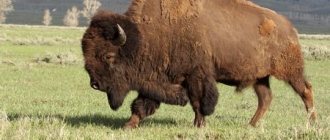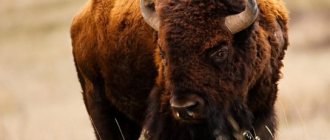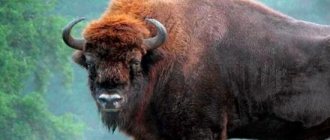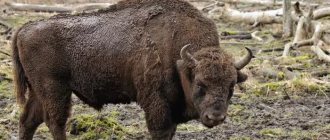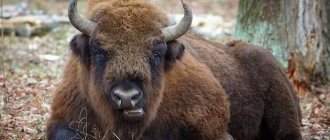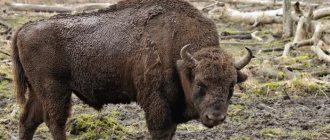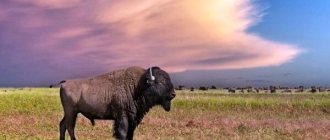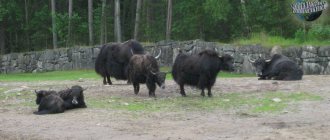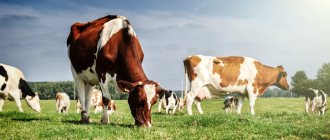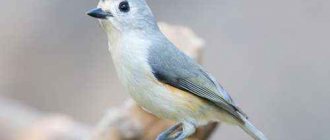Bison, bison and the completely incomprehensible creatures bison are at first glance indistinguishable to an ignorant person. One can only guess how they managed to call them differently and not get confused. However, you just have to take a closer look and start looking for differences, look at a few photos of bison and bison in comparison - and you are unlikely to ever make a mistake when determining which of the mighty bulls appeared before your eyes this time. Of course, you won’t be able to become a specialist right away, but it’s easy to show off your erudition in front of other amateurs!
What do bison drink?
In the summer, bison go to water twice a day, usually in the early morning and evening. In winter, horned animals can only get by on snow, but if there is access to bodies of water, they will definitely drink water.
Interesting materials:
Why is lunch lunch? Why did Lot's wife turn around? Why do clouds move? Why don't clouds fall physics? Why did Oblomov move to St. Petersburg? Why did Oblomov choose Agafya and not Olga? Why does the sausage casing turn white? Why do webs form? Why do my hands get so dry? Why do clothes dry out?
What do these two species have in common?
Both species belong to the order Bisonidae, which, like other wild bulls, have 13 pairs of ribs. These are large, massive animals covered with fur.
And one more feature that unites the two species is the recently looming danger of destruction. Wars, hunting and human industrial activity have caused enormous damage to both populations, bringing them to the brink of extinction. But then, thanks to environmental measures taken, the number of giants began to grow.
Some bison were brought to the Eastern Hemisphere, where they mixed with local bison. As a result, bison appeared, which are often found in the North Caucasus. These animals combine the characteristics of both species, but, as a rule, exceed them in size.
A long-standing dispute between zoologists
In the zoological classification, bison and bison differ only at the species level - they have the same family and genus. The difference between them and the possibility of being classified as two different species, and not smaller subgroups of one, is still being debated. Research by geneticists has shown a strong similarity in the paternal component of their chromosomes, but a significant difference in the maternal one, which makes it possible not to combine the animals into a group.
Despite this, some scientists have a different opinion - bison and bison are just subspecies. This statement is supported by the fact of free crossing of animals, which as a result produces viable, strong offspring, known as bison.
However, no matter how hard they try to classify them from a scientific point of view, the external differences between the bison and the bison are still obvious.
Reproduction and lifespan
Mating season for bison opens in May and lasts until mid-September. Animals are polygamous; they do not tend to form permanent pairs. A male bison forms a real harem of 3-5 cows. During the breeding season, large mixed herds are formed, where fierce competition prevails.
The struggle for the best females between strong males proceeds violently - fights lead not only to severe wounds, but also to the death of the opponent. Battles take place in the form of clashes of heads, desperate confrontation with each other. During the rut there is a dull roar in the herd. The general roar resembles the approach of a thunderstorm. You can hear the sounds of a roaring herd at a distance of 5-7 km.
After mating, females move away from the herd to bear offspring. The duration of pregnancy is 9-9.5 months. Closer to giving birth, cows look for secluded places for the birth of their offspring. There are cases of calves being born right in the herd.
A baby is born; the birth of two is very rare. If a birth occurs among other bison, they do not remain indifferent, they show interest and care - they sniff and lick the newborn baby.
The weight of the calf after birth is approximately 25 kg, its fur is light red, with a yellow tint. The baby has no horns or a hump at the withers. After one and a half to two hours of age, a small bison can stand on its feet and move behind its walking mother.
Until the age of one year, calves feed on mother's milk, the fat content of which is 12%. They quickly grow, gain strength, become stronger, and learn in the games of adult life. The first year of life is a dangerous time for them, since the defenselessness of babies attracts predators, especially wolf packs, for easy prey. The threat of attack also comes from grizzly bears and pumas.
The bison make sure that the calves do not move away from the herd and control their location. Puberty of young animals occurs at the age of 3-5 years. Under natural conditions, the life expectancy of bison is 20 years. In captivity, life expectancy increases by 5-10 years. The herbivorous giants are under the care of animal rights activists, although their habitat cannot be restored to its former size.
Habitats
Bison and bison - what is the difference between them? As an answer, you can also name their habitats.
Bison inhabit the North American continent.
The range of the bison was initially very wide - the plains and forests of the entire European part of Eurasia - from southern Scandinavia to Siberia. Now within the same limits they live mainly in nature reserves, nature reserves and zoos. Work is underway on active breeding and subsequent adaptation of animals to the natural conditions of the wild.
During the period of critical reduction in the number of bison, bison remained only in Belovezhskaya Pushcha and the Caucasus.
Appearance
Bison and bison, although similar to each other, are strikingly different from all other fauna of the Earth.
- They are the largest ungulate mammals in their range, measured by weight. The difference between bison and bison in body weight is significant - the former are much heavier, up to 1300 kg, while the latter usually do not exceed 850 kg.
- The body length of both adult males is on average up to 2.5-3 meters, height is about 2 m, the back is longer. Females of both species are noticeably smaller and lighter than males.
- The front part of the animal's body is wider, stronger and more developed than the back, and is covered with thick, long hair. The hair on the head is darker.
- The general body shape of bison can be conditionally almost fit into a square, bison - into an elongated rectangle. The bison looks more like an ordinary domestic bull.
- They have a pronounced hump formed by a short powerful neck and part of the back. Bison have a lower hump than bison. Males of both species are higher than females.
- The legs are rather short, but strong, the hind legs are longer than the front ones. Despite this, they reach speeds of up to 50 km/h. Bison have longer and slimmer legs.
- The head is low, although the bison is higher than the bison and has a wide forehead.
- Bison's horns are longer. In both bulls they are hollow, round in cross-section, black, smooth, curved outward, with the ends turned inward. The base of the horn is wider, gradually narrowing.
- Dark brown eyes, the whites are almost invisible, long eyelashes.
- The top of the head is covered with curly hair; on the neck and under the chest it is straight and long. There is a beard on the chin, more pronounced in bison.
- At the end of the tail there is a tassel. In bison it is more noticeable. Bison have a tail entirely covered with rather long hair, the density of which increases at the end, forming a brush. Bison's tail is shorter.
- Males and females are clearly distinguishable even from a distance. In females, the genitals and udder are almost invisible even during the feeding period. The genital organs of bulls are shifted to the lower abdomen and stand out noticeably.
Plains bison
- It has a large head covered with thick curly hair, over which the horns often hardly protrude.
- The fur cover of the front part of the body is well defined.
- The color is lighter than that of the forest bison.
- The beard is very thick, long under the throat, and continues behind the chest.
- Compared to its forest counterpart, the steppe one is smaller and lighter.
- The highest point of the hump is located at the level of the front legs.
Educational resource about culture, science and art
Bison
Author of the article: Sergey Kuriy Category: “Cultural zoology”
“...Perennial oaks have become majestic. A lily of the valley youth in the shadows, guarding someone's treasure... The children of your bison do not want to die out, Belovezhskaya Pushcha, Belovezhskaya Pushcha..." (from the song by N. Dobronravov and A. Pakhmutova)
“...And while the king was arguing with him like that, He had already eaten almost all the women and chickens, And this same bull or auroch was hanging around the palace itself.” (from a song by Vladimir Vysotsky)
Needless to say, the fate of the wild bulls of the tropics turned out to be much happier than the fate of their northern relatives. This was influenced by a whole range of reasons. Firstly, temperate bulls were found mainly in open steppe spaces, where you couldn’t really hide from a shot (yes, those same bison went into the forests much later). Secondly, it was difficult for them to resist European civilization with its plowing of fields, railways and firearms.
The wild tur bull (not to be confused with the mountain goat of the same name) was especially unlucky. It was a beautiful and very slender (compared to other bulls) animal - with a high-set head, high legs and long sharp horns. Female aurochs were brown in color, but males were pitch black, with a characteristic white “strap” running along the back.
Tour. 16th century image.
Once upon a time, the aurochs lived throughout the forest-steppe part of Europe up to the Western Caucasus, as well as in North Africa and Asia Minor (it was hunted by the ancient Assyrians). There are many descriptions of tur hunting in ancient Russian chronicles. An avid hunter, Vladimir Monomakh, recalled in his “Teachings to Children” how “two rounds tormented me with roses and a horse.” As you already understood, this bull was distinguished by its extraordinary strength and violent disposition. No wonder Russian princes were constantly compared to him. For example, in the “Ipatiev Chronicle” they wrote that Roman Mstislavovich was “brave bo yako tur”, and in “The Tale of Igor’s Campaign” Vsevolod Svyatoslavich is directly called “Bui-Tur”.
Tour based on an illustration from a book by Sigismund von Herberstein, published in 1556.
It is believed that the aurochs were the ancestors of the modern domestic cow. Those who did not have time to “domesticate” were removed completely. The last “buoy-tour” was killed already in 1627. Only in the 1920s did German zoologist brothers - Heinz and Lutz Heck - try to revive, if not the real tour, then its external copy. Essentially, they reversed artificial selection by selecting and crossbreeding domestic cows to fix and perpetuate the traits of their ancestor. Already in the 1930s, the brothers received very similar individuals, which even retained sexual dimorphism - the cows were brown, and the bulls were black with a white “belt”. But, of course, it was not a copy of the real tour, but some kind of genetic “cosplay”...
One of the restored "tours".
The other two species of wild bulls lasted much longer—European bison and North American bison. Outwardly, these bulls are very similar. They have massive humped withers, a sloping back and a lighter hindquarters. Their fur is shaggy and brown, and their horns are thick and relatively short. It is not easy to distinguish a bison from a bison, but it is possible. The bison is much more massive and hunchbacked, its head is set lower, and its shoulders, neck and head are covered with long, unkempt hair hanging from its muzzle like a beard.
Bison and bison.
Apparently, bison were found in sufficient numbers in medieval Russia. Back in 1696, the Ukrainian hetman Mazepa pleased Peter I by sending six moose, ten wild boars, two deer and one bison to his table.
But already in the 18th century, bison were on the verge of extinction. By the beginning of the 20th century, there were so few of them left that the word “bison” became a metaphor for everything obsolete, outdated, retrograde. For example, during the 3rd State Duma, the reactionary landowners-nobles were nicknamed “Kursk bison” by their opponents. The reason was the offended speech of Black Hundred deputy Nikolai Markov, who accused the newspapers of “presenting the excellent work of the Kursk zemstvo in the form of some kind of ridiculous bison exercise.” However, over time, the word “bison” acquired a positive connotation. It was used in relation to a strong, “selected”, rarely encountered personality type. For example, one can recall the perestroika story of the same name by Daniil Granin “Bison,” dedicated to the fate of geneticist Nikolai Timofeev-Resovsky, or the name of a unit of the Russian riot police.
Lifetime photograph of a Caucasian bison at the end of the 19th century.
The last European bison, like partisans, hid in the swampy forests of the Belarusian-Polish reserve Belovezhskaya Pushcha and the mountain thickets of the Caucasus. In 1914, there were still 727 individuals in the Pushcha. But a long series of wars - from the First World War to the Civil War - destroyed this livestock too. In 1921, the last free bison was killed in Pushcha, and by the end of the 1920s, their Caucasian relatives also disappeared.
Fortunately, bison still remained in zoos and private property. Established in 1923, the Society for the Conservation of Bison has done a lot of work to restore the population of these animals and return them to the wild - to the same Pushcha and the Ukrainian steppe reserve Askania-Nova. Therefore, today the bison is not only a symbol of Belovezhskaya Pushcha, but also, probably. throughout Belarus. There is even such vodka (more precisely, a bitter tincture) - “Zubrovka”, which was very popular both in Poland and in the USSR.
Bison.
The story of the bison was even more dramatic. If the bison were exterminated more or less gradually, then the North American wild bulls were brought to the brink of extinction in just a hundred years. Of course, the white population of America tried their best here. By the early 1830s, bison had already been exterminated in the eastern United States, but huge herds totaling 60 million animals still lived in the Wild West. One of the eyewitnesses said that he saw a closed herd of bison. stretching 40 km wide and 80 km long.
Buffalo.
However, in the 1860s they were taken seriously. This was largely due to the construction of railway lines. At first, workers were fed bison meat. One of the suppliers of meat for the builders of the Kansas Pacific Railway was the famous hunter William Cody, nicknamed “Buffalo Bill,” who managed to kill 4,280 bulls in just 18 months! The hunt was also made easier by the fact that bison often did not run away from a shot, but accumulated near a dead relative, trying to raise it. There were so many bulls that sometimes only the tongue of a killed animal was cut out, leaving the rest of the carcass to rot on the prairie. And some businessmen made a lot of money simply by collecting and processing numerous buffalo bones for fertilizer.
Mountain of dead bison skulls, USA, 1870
After construction was completed, the bison did not feel any better. As a “nice bonus,” railroad companies began offering passengers the opportunity to shoot bison directly from the windows of a moving train (a similar scene was reproduced at the beginning of Jim Jarmusch’s film “Dead Man”). This was already completely meaningless and disgusting “entertainment”...
Bison shooting on the transcontinental railroad. 19th century engraving.
Another reason for the extermination, although it made sense, was even more disgusting. When conservationists begged General Sheridan to stop the slaughter of the buffalo, he cynically replied that, on the contrary, “every hunter should be given a medal with a starving Indian on it.” Yes, yes, the extermination of bison was part of the genocidal policy that the white population of the United States carried out against the indigenous population (along with expelling them from their ancestral lands and distributing blankets contaminated with smallpox). One of the legends of the Kiowa tribe eloquently speaks about the special place of the bison in the life of Indian tribes:
“On the first day, the Great Spirit planted the Tree of the Great Path on the banks of the waters, raising its branches to the sky. And along them all living creatures descended to the earth, as well as the man and woman of Kiova, who walked all day through the new world, and in the evening they returned to the Tree of the Great Path, and there they saw bison, and the Great Spirit descended to them and said: “ Here are the bison. They will give you food and clothing, but on the day when you see that they have disappeared from the face of the earth, know that the end of Kiowa is near and the sun will set.”
As we know, the legend turned out to be prophetic in many ways...
Card Bodmer. Indian buffalo hunt.
In general, by 1900, only about a thousand individuals remained from the multimillion-dollar bison population. We owe part of the preservation of the species to an Indian named Wandering Coyote. In 1837, he captured a male and female bison, and 23 years later he already had a herd of 300 animals. Subsequently, the American government bought this herd and settled it in Yellowstone National Park. It was this that became the starting point for the restoration of the buffalo herd. This was systematically taken up in December 1905, when the Bison Rescue Society arose. According to the latest data, today the number of wild and semi-domestic bison has exceeded half a million individuals.
Bison.
Author: Sergey Kuriy February 2022
Difference between bison and bison
- The animals have different natural habitats: bison lived in North America, and bison lived in Eurasia.
- Bison are heavier and more powerful than bison.
- The bison's body is longer than that of the bison, while the bison's body is more compact.
- Bison lived on the prairies, while bison prefer forested areas.
- The bison has more black tones, while the bison has more brown tones.
The bison
(Bison bonasus)
is a wild forest bull, the largest ungulate animal on the European continent, which is rightfully considered a contemporary of the mammoth.
The body length of a bull
reaches 3 - 3.5 meters,
height at the shoulder
is 1.7 - 2 meters, weight can reach one ton. The bison's fur on the front part of the body is thick, soft and long, which visually makes it appear even more massive and powerful. But the bison’s voice is more like a dull grunt and does not fit well with the impression of the animal – a giant.
Written data about the bison has been known since the 3rd century BC, and the fossil remains of the ancestors of the bison date back to the Pliocene (1.5 million years ago). For most peoples, this powerful and beautiful animal personified the forces of nature, had a traditional cult meaning, and was worshiped as one of the symbols of their native land.
The bison is a symbol of the entire environmental movement to save rare and endangered species of animals
. Thanks to breeding in nurseries, it has become the only species in the world that has survived only in captivity and is successfully returning to the wild!
Only man is to blame for the disappearance of the bison in the wild. Poaching, cutting down and burning forests, and the unrestricted shooting of animals during periods of wars, popular unrest and revolutions led to the fact that by 1927 the bison was completely exterminated in the wild. In 1927, all over the world, and only in captivity, there were only 48 bison left in European zoos. From 1933 to 1939, there lived in the USSR a single purebred bison named Bodo, miraculously preserved in a reserve near Kherson.
Thanks to the activities of nurseries and zoological gardens, the bison was saved from complete extinction. The current global population size is
There are about 4,500 bison, of which about 3,000 animals live in the wild.
How long do bison live?
Bison cannot be considered one of the longest-living animals. Their lifespan is relatively short and does not exceed 30 years. Males usually live 10 years less than females. The recorded age limit for males is 23 years, but most of them die of old age at the age of 19-20 years. Bison grow quite slowly. Males reach full physical development by 10 years, females by 7 years.
How long does bison pregnancy last?
Females bring their first bison when they reach the age of three. Pregnancy lasts about 9 months. Nine to ten month old calves are separated from their mothers. Most bison calves are born in May-June.
What do bison eat?
Bison feed on herbaceous and woody plants. They graze mainly in forest clearings and in the floodplains of small rivers and streams, and in the fall in mown clearings, eating the remnants. The most favorite tree species are willow, aspen and oak. Bison eat thin branches with leaves, strip off young trees and eat the bark. They love acorns very much.
In the nursery, in the summer, bison are fed twice a day with compound feed and wood feed, and in winter they also add hay and succulent feed - chopped beets or carrots. On average, an adult bison receives about 2 kg of feed per feeding, and an adult bison – 3 kg. Bison begin to receive dry food from the age of two months. Each pen has salt lick with mineral additives.
What is the character of a bison?
By their nature, bison are rather timid, shy animals. In the forest, when free, they usually avoid meeting people and, when they see him, run away. In the pens of the nursery they behave much more boldly, although they obey the bison breeders. Bison remember very well the sounds that accompany the distribution of food. For example, in a nursery, bison come for breakfast and dinner (they do not have lunch) at the sound of a hunting horn or bugle.
What is the difference between bison and bison?
The differences between bison and American bison are minor. The bison has a higher hump, different in shape, longer horns and a tail. The head of the bison is set higher than that of the bison. The bison's body fits into a square, while the bison's body fits into an elongated rectangle, that is, the bison has a longer back and shorter legs. In the hot season, the back of the bison is covered with very short hair, almost bald, while the bison has hair developed all over its body at all times of the year. Both species are approximately the same in size, although the American bison, due to its stockiness, looks more compact and stronger.
The differences between these animals are very small, which is why scientists believe that they had a single ancestor. It’s just that part of the livestock migrated along the land crossing that existed at that time to North America. It is so difficult to distinguish between animals that the artist, when designing the US five-cent coin, made a mistake and drew a bison, not a bison, on it.
Lifestyle
- They live in groups. The number in normal times ranges from one to several dozen heads. The group consists of females and immature bulls, which separate as adults to join to satisfy the instinct of procreation. At other times, they exist alone or in groups of 10-15 males. The number of herds can increase during rutting (reproduction) periods to several hundred and even thousands of individuals. During periods of food shortage, on the contrary, groups are divided into even smaller ones.
- The breeding season begins in May and ends in September.
- Bison often form large herds due to their larger numbers and lifestyle (especially the lowland subspecies).
- They occupy a permanent territory with an area of 30-100 km 2, depending on weather conditions and the availability of food.
- Active during the day, resting at night.
- They eat plant foods in the morning and evening.
- At rest they make sounds similar to mooing, during periods of danger and running - similar to snoring or grunting.
- Close connections between individuals. Cases of returning to the bodies of dead animals have been observed.
Differences between bison and bison
Bison are larger than bison, have a more massive hump and a low-set head. The bison sheds heavily in the summer, while the bison does not have such a pronounced molting period. The North American animal has smaller horns and a short tail. If we approximately fit both animals into a geometric figure, then the bison is square, and the bison’s body more closely resembles an elongated rectangle.
Both species interbreed well in the wild and in captivity. They say that in the enclosure complex of the village of Zhudre, located in the Oryol Polesie, where both species live, an amazing incident occurred long ago. The bison took a liking to the female bison, and the wild animal, breaking through several enclosures, ran to its beloved. However, a male bison stood in his way, and a bloody fight ensued. The fight was terrible. They tried to separate the animals, but it was almost impossible to cope with the two giants. As a result, the bison killed the leader of the bison herd and took away the female.
Bison and bison still live in the enclosure complex. You can look at them at any time. To do this, just come to the Oryol region, staying at a camp site in a cozy house. After spending the night, in the morning you can go look and compare the furry, formidable inhabitants of forests and prairies.
The enclosure complex is also home to other interesting animals - foxes, wolves, bears, wild boars, deer, etc. So no one will be left without beautiful photos and memorable impressions.
